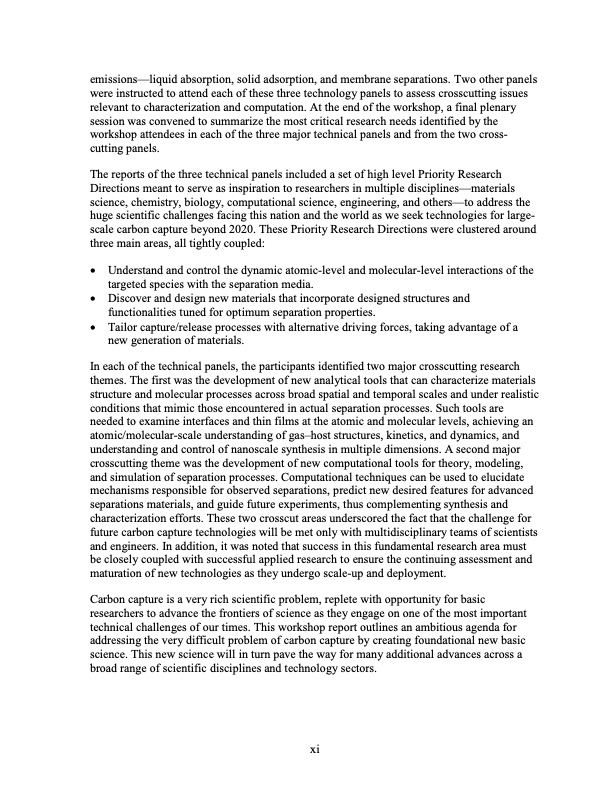
PDF Publication Title:
Text from PDF Page: 013
emissions—liquid absorption, solid adsorption, and membrane separations. Two other panels were instructed to attend each of these three technology panels to assess crosscutting issues relevant to characterization and computation. At the end of the workshop, a final plenary session was convened to summarize the most critical research needs identified by the workshop attendees in each of the three major technical panels and from the two cross- cutting panels. The reports of the three technical panels included a set of high level Priority Research Directions meant to serve as inspiration to researchers in multiple disciplines—materials science, chemistry, biology, computational science, engineering, and others—to address the huge scientific challenges facing this nation and the world as we seek technologies for large- scale carbon capture beyond 2020. These Priority Research Directions were clustered around three main areas, all tightly coupled: • Understand and control the dynamic atomic-level and molecular-level interactions of the targeted species with the separation media. • Discover and design new materials that incorporate designed structures and functionalities tuned for optimum separation properties. • Tailor capture/release processes with alternative driving forces, taking advantage of a new generation of materials. In each of the technical panels, the participants identified two major crosscutting research themes. The first was the development of new analytical tools that can characterize materials structure and molecular processes across broad spatial and temporal scales and under realistic conditions that mimic those encountered in actual separation processes. Such tools are needed to examine interfaces and thin films at the atomic and molecular levels, achieving an atomic/molecular-scale understanding of gas–host structures, kinetics, and dynamics, and understanding and control of nanoscale synthesis in multiple dimensions. A second major crosscutting theme was the development of new computational tools for theory, modeling, and simulation of separation processes. Computational techniques can be used to elucidate mechanisms responsible for observed separations, predict new desired features for advanced separations materials, and guide future experiments, thus complementing synthesis and characterization efforts. These two crosscut areas underscored the fact that the challenge for future carbon capture technologies will be met only with multidisciplinary teams of scientists and engineers. In addition, it was noted that success in this fundamental research area must be closely coupled with successful applied research to ensure the continuing assessment and maturation of new technologies as they undergo scale-up and deployment. Carbon capture is a very rich scientific problem, replete with opportunity for basic researchers to advance the frontiers of science as they engage on one of the most important technical challenges of our times. This workshop report outlines an ambitious agenda for addressing the very difficult problem of carbon capture by creating foundational new basic science. This new science will in turn pave the way for many additional advances across a broad range of scientific disciplines and technology sectors. xiPDF Image | 2020 Carbon Capture

PDF Search Title:
2020 Carbon CaptureOriginal File Name Searched:
1291240.pdfDIY PDF Search: Google It | Yahoo | Bing
NFT (Non Fungible Token): Buy our tech, design, development or system NFT and become part of our tech NFT network... More Info
IT XR Project Redstone NFT Available for Sale: NFT for high tech turbine design with one part 3D printed counter-rotating energy turbine. Be part of the future with this NFT. Can be bought and sold but only one design NFT exists. Royalties go to the developer (Infinity) to keep enhancing design and applications... More Info
Infinity Turbine IT XR Project Redstone Design: NFT for sale... NFT for high tech turbine design with one part 3D printed counter-rotating energy turbine. Includes all rights to this turbine design, including license for Fluid Handling Block I and II for the turbine assembly and housing. The NFT includes the blueprints (cad/cam), revenue streams, and all future development of the IT XR Project Redstone... More Info
Infinity Turbine ROT Radial Outflow Turbine 24 Design and Worldwide Rights: NFT for sale... NFT for the ROT 24 energy turbine. Be part of the future with this NFT. This design can be bought and sold but only one design NFT exists. You may manufacture the unit, or get the revenues from its sale from Infinity Turbine. Royalties go to the developer (Infinity) to keep enhancing design and applications... More Info
Infinity Supercritical CO2 10 Liter Extractor Design and Worldwide Rights: The Infinity Supercritical 10L CO2 extractor is for botanical oil extraction, which is rich in terpenes and can produce shelf ready full spectrum oil. With over 5 years of development, this industry leader mature extractor machine has been sold since 2015 and is part of many profitable businesses. The process can also be used for electrowinning, e-waste recycling, and lithium battery recycling, gold mining electronic wastes, precious metals. CO2 can also be used in a reverse fuel cell with nafion to make a gas-to-liquids fuel, such as methanol, ethanol and butanol or ethylene. Supercritical CO2 has also been used for treating nafion to make it more effective catalyst. This NFT is for the purchase of worldwide rights which includes the design. More Info
NFT (Non Fungible Token): Buy our tech, design, development or system NFT and become part of our tech NFT network... More Info
Infinity Turbine Products: Special for this month, any plans are $10,000 for complete Cad/Cam blueprints. License is for one build. Try before you buy a production license. May pay by Bitcoin or other Crypto. Products Page... More Info
| CONTACT TEL: 608-238-6001 Email: greg@infinityturbine.com | RSS | AMP |